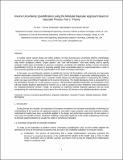| dc.contributor.author | Wu, Xu | |
| dc.contributor.author | Kozlowski, Tomasz | |
| dc.contributor.author | Meidani, Hadi | |
| dc.contributor.author | Shirvan, Koroush | |
| dc.date.accessioned | 2021-10-27T20:10:18Z | |
| dc.date.available | 2021-10-27T20:10:18Z | |
| dc.date.issued | 2018 | |
| dc.identifier.uri | https://hdl.handle.net/1721.1/135012 | |
| dc.description.abstract | © 2018 Elsevier B.V. In nuclear reactor system design and safety analysis, the Best Estimate plus Uncertainty (BEPU) methodology requires that computer model output uncertainties must be quantified in order to prove that the investigated design stays within acceptance criteria. “Expert opinion” and “user self-evaluation” have been widely used to specify computer model input uncertainties in previous uncertainty, sensitivity and validation studies. Inverse Uncertainty Quantification (UQ) is the process to inversely quantify input uncertainties based on experimental data in order to more precisely quantify such ad-hoc specifications of the input uncertainty information. In this paper, we used Bayesian analysis to establish the inverse UQ formulation, with systematic and rigorously derived metamodels constructed by Gaussian Process (GP). Due to incomplete or inaccurate underlying physics, as well as numerical approximation errors, computer models always have discrepancy/bias in representing the realities, which can cause over-fitting if neglected in the inverse UQ process. The model discrepancy term is accounted for in our formulation through the “model updating equation”. We provided a detailed introduction and comparison of the full and modular Bayesian approaches for inverse UQ, as well as pointed out their limitations when extrapolated to the validation/prediction domain. Finally, we proposed an improved modular Bayesian approach that can avoid extrapolating the model discrepancy that is learnt from the inverse UQ domain to the validation/prediction domain. | |
| dc.language.iso | en | |
| dc.publisher | Elsevier BV | |
| dc.relation.isversionof | 10.1016/J.NUCENGDES.2018.06.004 | |
| dc.rights | Creative Commons Attribution-NonCommercial-NoDerivs License | |
| dc.rights.uri | http://creativecommons.org/licenses/by-nc-nd/4.0/ | |
| dc.source | arXiv | |
| dc.title | Inverse uncertainty quantification using the modular Bayesian approach based on Gaussian process, Part 1: Theory | |
| dc.type | Article | |
| dc.contributor.department | Massachusetts Institute of Technology. Department of Nuclear Science and Engineering | |
| dc.relation.journal | Nuclear Engineering and Design | |
| dc.eprint.version | Original manuscript | |
| dc.type.uri | http://purl.org/eprint/type/JournalArticle | |
| eprint.status | http://purl.org/eprint/status/NonPeerReviewed | |
| dc.date.updated | 2019-09-26T15:53:10Z | |
| dspace.orderedauthors | Wu, X; Kozlowski, T; Meidani, H; Shirvan, K | |
| dspace.date.submission | 2019-09-26T15:53:11Z | |
| mit.journal.volume | 335 | |
| mit.license | PUBLISHER_CC | |
| mit.metadata.status | Authority Work and Publication Information Needed | |
